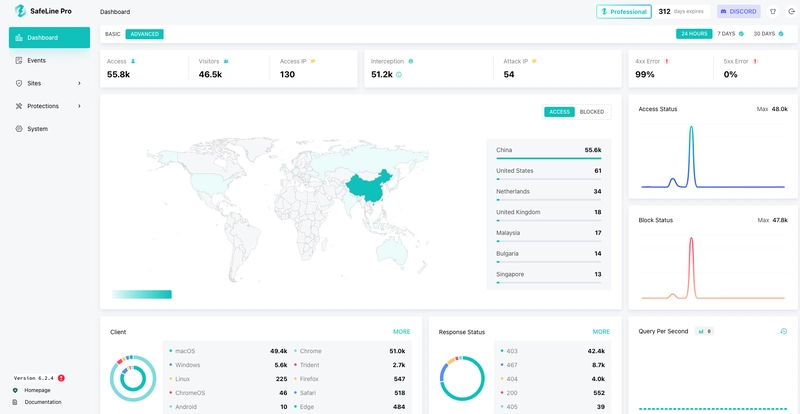Choosing a Web Application Firewall (WAF) shouldn’t feel like reading a vendor whitepaper. As developers, what we really care about is:
- How fast can I deploy it?
- Do I have full control, or am I locked into someone’s cloud?
- Will it actually catch modern attacks, or just block basic patterns?
- And—how much is this going to cost me at scale?
Two names often come up: SafeLine WAF and AWS WAF. Both protect against modern web threats, but they’re built for very different worlds. Here’s a breakdown that cuts through the marketing.
Quick Comparison
| Feature | SafeLine WAF | AWS WAF |
|---|---|---|
| Deployment | Self-hosted (Docker, VMs, bare-metal) | AWS-only, tied to CloudFront / ALB / API Gateway |
| Detection | Semantic engine (detects obfuscated & 0-day style attacks) | Rule-based (regex, IP sets, rate limits) |
| Customization | High – full config, plugins, log control | Moderate – via AWS Console & APIs |
| Latency | Low (depends on your infra) | Low (if fully on AWS) |
| Integration | Any stack via proxy | Best for AWS-native services |
| Logging | Local logs, syslog, full visibility | CloudWatch metrics & logs |
| Pricing | Free to start, Pro version cheaper than most vendors | Pay-per-request + per-rule (adds up fast) |
Deployment Styles: Control vs Convenience
- SafeLine → Runs anywhere. You drop it in as a reverse/transparent proxy. Perfect if you’re hybrid, multi-cloud, or even fully on-prem. Full visibility, no cloud lock-in.
- AWS WAF → Feels seamless if you’re 100% in AWS. Rules apply at CloudFront, ALB, or API Gateway level. But it won’t help if you want to protect apps outside AWS.
Detection Capabilities: Signatures vs Semantics
SafeLine uses a semantic analysis engine. Instead of just matching regex rules, it parses requests like a human would. This means it can spot obfuscated XSS, SQLi payloads, and logic-based attacks that slip past traditional rules.
AWS WAF relies on managed rules or your custom ones. Solid for known patterns and volumetric attacks, but weaker against evasive payloads or unknown threats.
Real-World Use Cases
| Scenario | Go With |
|---|---|
| Want full control or hybrid deployment | ✅ SafeLine |
| Already 100% on AWS stack | ✅ AWS WAF |
| Need advanced detection of obfuscated payloads | ✅ SafeLine |
| Want CloudFront-level protection for global traffic | ✅ AWS WAF |
| Care about raw log access & tuning | ✅ SafeLine |
Bottom Line
Choose SafeLine WAF if you want maximum control, self-hosted flexibility, and detection that goes beyond simple regex. It’s developer-first, open-source, and affordable.
Choose AWS WAF if your entire app stack already lives on AWS and you just want a managed solution with minimal ops overhead.
Learn more
- SafeLine GitHub: github.com/chaitin/SafeLine
- SafeLine Docs: https://docs.waf.chaitin.com/
- SafeLine Community:https://discord.gg/dy3JT7dkmY
- AWS WAF Docs: docs.aws.amazon.com/waf
- AWF WAF GitHub: github.com/aws-solutions/aws-waf-security-automations




Top comments (2)
Using AWS WAF gives tight integration with AWS services, gb whatsapp download managed updates, and scalability handled automatically by Amazon. Its managed rules, dashboards, APIs and logging make things easier when your infrastructure already lives in AWS.
Interesting breakdown, this trade-off between control and convenience reminds me of the choices we face when building pipelines on AWS. For example, here’s a post on designing a serverless social media ingestion and analytics pipeline that explores scalability and cost considerations in a similar way